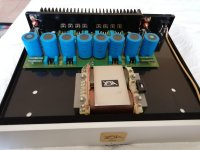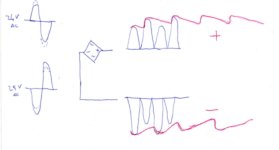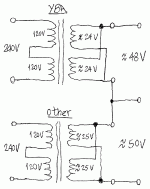Hello, I have a beatiful YBA Delta 3 power amp:

and I'd want to add a second trafo to obtain a HC-DT version, more stable and agile with my 3-4 ohms Thiel CS2.4. Somebody gave me a trafo which seems identical in dimensions and weight to the factory one but measuring its ouput it has a +1.2 volt higher voltage per winding than the factory one, and wiring it using the paralleled windings per branch, I obtain a wonderful result in terms of current but a very light 50 hz buzz at speakers, probably due to the slight asimmetry of the two branches.
My question is:

and I'd want to add a second trafo to obtain a HC-DT version, more stable and agile with my 3-4 ohms Thiel CS2.4. Somebody gave me a trafo which seems identical in dimensions and weight to the factory one but measuring its ouput it has a +1.2 volt higher voltage per winding than the factory one, and wiring it using the paralleled windings per branch, I obtain a wonderful result in terms of current but a very light 50 hz buzz at speakers, probably due to the slight asimmetry of the two branches.
My question is:
- does somebody knows the specs of the factory trafo, in terms of Volt and Amperes?
- is it still possible to find in commerce any of that, so I can find a paired couple?
- is there any more modern suitable trafo (not toroidal in respect of Yves Bernard Andre ideas), such as R-core, even with higher current, I can use, paired, instead?
Hello Andrea,
I have many clients asking for YBA power transformers to do DT upgrades and large power supplies for CD players..
Unfortunately, the only way to procure them is to buy old YBA units and take out the transformer(s).
Normally you could parallel the windings but since their secondary voltages are not identical on both transformers, they are fighting each other and create the hum you can hear.
You can use your second transformer but will need to parallel the windings of each transformers and use one to make the positive and the other for the negative.
You will end up with the voltage slightly higher on one polarity but this of no consequence.
Do not hesitate if you have more questions or need original YBA parts as I do have some.
Good luck!
Michel
I have many clients asking for YBA power transformers to do DT upgrades and large power supplies for CD players..
Unfortunately, the only way to procure them is to buy old YBA units and take out the transformer(s).
Normally you could parallel the windings but since their secondary voltages are not identical on both transformers, they are fighting each other and create the hum you can hear.
You can use your second transformer but will need to parallel the windings of each transformers and use one to make the positive and the other for the negative.
You will end up with the voltage slightly higher on one polarity but this of no consequence.
Do not hesitate if you have more questions or need original YBA parts as I do have some.
Good luck!
Michel
Attachments
Hello Michel, you're really welcome, I'm lucky to meet you! The scheme I followed is the same you posted (ac output voltage would remains 24 and 25 volt being windings in parallel, not 48 and 50, right?) , since I've read in a old post of yours about this YBA criterion. Due to slight voltage differences between the two trafos, I think that after the bridge, both on positive branch and on negative there's a sequence of high and low peak, giving a simmetrycal average dc voltage but with larger irregularities than that resulting from a perfectly symmetrical branch, producing the slight hum; see the attached image representing my assumption:

Differences in image is deliberately drawn expanded to better render idea, and in practice the hum is just listenable putting strictly ear against speaker cone, a very small price to pay compared to the enormous benefit in terms of dynamics and sonic fluidity produced by doubling the supply current, of course.
I ask your opinion about:
- is really better this solution of paralleling windings and use one trafo per branch compared a dual mono design, in which one trafo works in the classic way for only one channel, since motherboard dual mono design would allow it easily? Wouldn't current however overall doubled even if divided separately for two channels? Why YBA preferred the parallel windings solution rather than the dual mono?
More, would you be able to give me an idea on how to check regularly polarisation bias in this amp model to avoid, over time, distorsions or bad surprises?

Differences in image is deliberately drawn expanded to better render idea, and in practice the hum is just listenable putting strictly ear against speaker cone, a very small price to pay compared to the enormous benefit in terms of dynamics and sonic fluidity produced by doubling the supply current, of course.
I ask your opinion about:
- is really better this solution of paralleling windings and use one trafo per branch compared a dual mono design, in which one trafo works in the classic way for only one channel, since motherboard dual mono design would allow it easily? Wouldn't current however overall doubled even if divided separately for two channels? Why YBA preferred the parallel windings solution rather than the dual mono?
More, would you be able to give me an idea on how to check regularly polarisation bias in this amp model to avoid, over time, distorsions or bad surprises?
If the difference between the two transformer secondaries is the problem (I'm a bit skeptical), you should be able to share the secondaries so that you get two equal secondaries of 49VAC each. Please advise if you don't understand what I'm suggesting.
Good luck!
Good luck!
YBA has always preferred to double the available current instead of modify to dual mono.
You should not have to check regularly if the bias is right.
You set it once and you forget about it, unless you know your potentiometer is unreliable.
I have seen unreliable black Piher potentiometers in the past.
If you have to replace it, I suggest you use PTC10LV10-103A1010, a better version.
You should not have to check regularly if the bias is right.
You set it once and you forget about it, unless you know your potentiometer is unreliable.
I have seen unreliable black Piher potentiometers in the past.
If you have to replace it, I suggest you use PTC10LV10-103A1010, a better version.
Hello, I'm skeptical too but unfortunately I haven't made a near come hearing before adding second trafo to verify if hum presence is due to It or is and inherent design feature.If the difference between the two transformer secondaries is the problem (I'm a bit skeptical), you should be able to share the secondaries so that you get two equal secondaries of 49VAC each. Please advise if you don't understand what I'm suggesting.
Good luck!
However what do you mean about sharing the secondaries? Maybe putting in parallel each higher voltage winding with a corresponding lower voltage one? What may happen in this case to the primary of the lower voltage secondaries in which returns a higher voltage from the other?
If you would know the exact voltage and VA ratings you could buy 2 identical transformers. I think that is the only solution leading to your desired outcome (except finding an original one of course).
BTW never use different voltage windings in parallel as the transformers will protest. Oh and yes, did you check the primary windings of the ones you have now? Maybe they have different primary taps and things can be equalled there.
BTW never use different voltage windings in parallel as the transformers will protest. Oh and yes, did you check the primary windings of the ones you have now? Maybe they have different primary taps and things can be equalled there.
Thank you, but believe me, I wasn't able to find in commerce any R-core or similar to YBA tipology of, let's say, 24+24 volts, 150 voltamperes, do you know any?If you would know the exact voltage and VA ratings you could buy 2 identical transformers. I think that is the only solution leading to your desired outcome (except finding an original one of course).
As figured, infact. An alternative May be ti use a pair of diodes in counterphase after the higher voltage winding to obtain a fall of 1,2 volt and realign output with the other, what do you think about?BTW never use different voltage windings in parallel as the transformers will protest. Oh and yes, did you check the primary windings of the ones you have now? Maybe they have different primary taps and things can be equalled there.
In toroid that is no problem. Finding an r-core version will be a problem possibly leading to obscure quality or obscure sources. That original one is not an r-core transformer is it?
https://talema.com/wp-content/uploads/datasheets/Open-Style-230V-Primary-0160VA.pdf
I don't know anything about your amplifier or YBA as a brand but if it is class A or high biased class AB I would not hesitate to use 2 x SMPS of high quality. Way less ripple voltage and current in abundance. Lighter, less heat, higher efficiency and way less expensive too. Perfect application contrary to SMPS in low power applications. Yes we can all hate SMPS but not when they are applied right i.e. in current demanding situations.
Or just leave it like it is, sell the second transformer and replace the 3-4 ohms Thiel CS2.4. System choices always lead to difficult to solve dilemmas. You married the wrong persons in an unstable marriage.
https://talema.com/wp-content/uploads/datasheets/Open-Style-230V-Primary-0160VA.pdf
I don't know anything about your amplifier or YBA as a brand but if it is class A or high biased class AB I would not hesitate to use 2 x SMPS of high quality. Way less ripple voltage and current in abundance. Lighter, less heat, higher efficiency and way less expensive too. Perfect application contrary to SMPS in low power applications. Yes we can all hate SMPS but not when they are applied right i.e. in current demanding situations.
Or just leave it like it is, sell the second transformer and replace the 3-4 ohms Thiel CS2.4. System choices always lead to difficult to solve dilemmas. You married the wrong persons in an unstable marriage.
Last edited:
It seems to me that YBA trafo Is a R-core similar type, I've read somewhere that Yves-Bernard André preferred that rather than toroidal for audio applications. However what do you mean for 'SMPS' please?I don't know anything about your amplifier or YBA as a brand but if it is class A or high biased class AB I would not hesitate to use 2 x SMPS. Way less ripple voltage and current in abundance
The one in the picture is definitely not a toroid nor an r-core type! Maybe the guy meant to prefer the classic EI, C types and r-core transformers over toroids which is understandable. Discussing this will fill pages with blah blah but as usual the most common (= cheapest) solution is not technically the best in quality audio but marketed as such. Besides that any niche brand must do something different to differ from the others.
SMPS: Switchers, Switched Mode Power Supplies. In audio hated by many and loved by many 🙂 Here an example but no endorsement of this brand as I have seen a few defective ones (the amplifiers and 1 PSU AFAIK) so I keep neutral. Just as an example. Designed by good engineers but that does not tell all. Yes that is 2 x 1200W (peak power 2 x 1350W). Absurd but true. That is another story than using 2 x 160 VA toroids/r-cores. Just 1 of them would be more than enough really with 600W relatively clean power per channel. A nice test to do.
https://www.hypex.nl/products/smps-family/smps1200a180
https://www.hypex.nl/media/8c/22/86/1646037796/SMPS1200Axx0_10xx.pdf
The search for high quality proven good ones (preferably also affordable) is up to you. An absolute bonus is that the amplifier is then also portable 😀
SMPS: Switchers, Switched Mode Power Supplies. In audio hated by many and loved by many 🙂 Here an example but no endorsement of this brand as I have seen a few defective ones (the amplifiers and 1 PSU AFAIK) so I keep neutral. Just as an example. Designed by good engineers but that does not tell all. Yes that is 2 x 1200W (peak power 2 x 1350W). Absurd but true. That is another story than using 2 x 160 VA toroids/r-cores. Just 1 of them would be more than enough really with 600W relatively clean power per channel. A nice test to do.
https://www.hypex.nl/products/smps-family/smps1200a180
https://www.hypex.nl/media/8c/22/86/1646037796/SMPS1200Axx0_10xx.pdf
The search for high quality proven good ones (preferably also affordable) is up to you. An absolute bonus is that the amplifier is then also portable 😀
Last edited:
PS it would be necessary to remove rectifying diodes when moving over to SMPS and solder sturdy PCB connectors on the PCB. Preferably of the screw type. As a side note: the rectifier diodes seem to have been used in parallel in the first picture which is considered non optimal design practice.
I ditched all internals for a 3A years ago. I have retained both trafos and main board. Will verify my claim on tuesday next week, as the parts are in my Norwegian abode.
I have also retained lot of the original internal cabling from the same operation.
R
I have also retained lot of the original internal cabling from the same operation.
R
Thank you very much, I'll be really grateful if you'll keep me informed, I would be interested in keeping them if you agree.I ditched all internals for a 3A years ago. I have retained both trafos and main board. Will verify my claim on tuesday next week, as the parts are in my Norwegian abode.
I have also retained lot of the original internal cabling from the same operation.
R
..I must say that temptation in strong for the price....I could leave levelling capacitor on the mainboard and remove diodes as you said..what people who hate this tecnology says in defense of their negative vote?SMPS: Switchers, Switched Mode Power Supplies. In audio hated by many and loved by many 🙂 Here an example but no endorsement of this brand as I have seen a few defective ones (the amplifiers and 1 PSU AFAIK) so I keep neutral. Just as an example. Designed by good engineers but that does not tell all. Yes that is 2 x 1200W (peak power 2 x 1350W). Absurd but true. That is another story than using 2 x 160 VA toroids/r-cores. Just 1 of them would be more than enough really with 600W relatively clean power per channel. A nice test to do.
https://www.hypex.nl/products/smps-family/smps1200a180
https://www.hypex.nl/media/8c/22/86/1646037796/SMPS1200Axx0_10xx.pdf
Well I deal with SMPS in professional high power applications where they do a very good job. In low power (sub 50VA) I think they too often are a drama and inferior to way less noisy and nearly no EMI creating linear PSUs. Consumer grade are not very reliable too.
In amplifiers they can be just the right solution. Much less ripple voltage and abundance of power are key points.
Many of them are allergic to high value capacitors at the load.
In amplifiers they can be just the right solution. Much less ripple voltage and abundance of power are key points.
Many of them are allergic to high value capacitors at the load.
- Home
- Amplifiers
- Solid State
- A second trafo for YBA Delta 3 power amp
